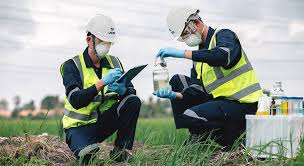Environmental impact assessment process Egypt is a comprehensive and critical procedure in the country's efforts to ensure sustainable development and environmental protection. This process involves the evaluation of the potential environmental and social impacts of proposed projects and activities, and it plays a crucial role in informing decision-making and promoting sustainable development. In this article, we will explore Egypt's environmental impact assessment process, its significance, and the key considerations involved in ensuring its effectiveness in safeguarding the country's environment and natural resources.
The environmental impact assessment (EIA) process in Egypt is conducted to ensure that potential environmental impacts of proposed projects or activities are rigorously evaluated before they are approved. The process involves identifying, predicting, and evaluating the potential environmental effects of a proposed project or development on the natural and human environment. It also includes providing measures to mitigate and manage any adverse impacts. In Egypt, the EIA process is carried out according to the country's environmental laws and regulations. The process involves a series of steps, including screening, scoping, assessment, public consultation, and decision-making. The goal is to ensure that environmental considerations are integrated into project planning and decision-making. The EIA process in Egypt involves the participation of various stakeholders, including government agencies, project proponents, environmental experts, and the public. The process is designed to be transparent and participatory, to ensure that all relevant perspectives and concerns are taken into account. Overall, the EIA process in Egypt plays a crucial role in promoting sustainable development and ensuring that environmental considerations are integrated into project planning and decision-making. By rigorously evaluating potential environmental impacts and providing measures to mitigate adverse effects, the EIA process helps to protect Egypt's natural environment and resources.
The Importance of Environmental Impact Assessment Process in Egypt

The environmental impact assessment process in Egypt plays a crucial role in ensuring that development projects do not harm the environment. It involves the evaluation of potential environmental impacts of proposed actions and aims to mitigate any negative effects. This process is essential for sustainable development and the protection of Egypt's natural resources. By involving all stakeholders and abiding by regulations and policies, successful environmental impact assessments can be achieved. As Egypt continues to develop, the integration of environmental impact assessment into its development plans is crucial for the preservation of its environment for future generations.
The Environmental Impact Assessment (EIA) process in Egypt is of crucial importance in safeguarding the country's natural resources and ecosystems. It plays a vital role in identifying and mitigating potential environmental and social impacts of development projects. The EIA process ensures that proposed projects are in compliance with national and international environmental regulations and standards. In Egypt, the EIA process involves a thorough evaluation of the potential environmental impacts of projects, including infrastructure development, industrial facilities, and urban expansion. It also considers the social and economic implications of these projects on local communities. The EIA process in Egypt is overseen by the Ministry of Environment, which is responsible for issuing Environmental Impact Assessment approvals and monitoring compliance with environmental regulations. The EIA process also involves public participation and consultation with stakeholders, ensuring that their concerns and suggestions are taken into account. Overall, the EIA process in Egypt is a critical tool for sustainable development, helping to minimize the negative impacts of development projects and promoting the conservation of Egypt's natural environment and resources. It is an essential component of the country's environmental management efforts and contributes to the overall well-being of its people and ecosystems.
Challenges and Opportunities for Environmental Impact Assessment in Egypt

Challenges for Environmental Impact Assessment in Egypt include issues such as limited technical capacity and resources, incomplete or outdated environmental laws and regulations, and inadequate public participation and stakeholder engagement. Additionally, there is a lack of consistent monitoring and enforcement of environmental regulations, and a need for improved coordination and cooperation among government agencies and stakeholders. Opportunities for Environmental Impact Assessment in Egypt include the potential for improved infrastructure and capacity building, increased investment in renewable energy and sustainable development projects, and the opportunity to integrate environmental considerations into the country's overall development planning. There is also the potential for increased public awareness and engagement on environmental issues, as well as opportunities for international collaboration and knowledge sharing.
The Role of Stakeholders in the Environmental Impact Assessment Process in Egypt
environmental consulting firms

The environmental impact assessment (EIA) process in Egypt involves the participation of various stakeholders who are affected by or have an interest in the proposed project. These stakeholders can include government agencies, local communities, non-governmental organizations (NGOs), and private enterprises. The role of stakeholders in the EIA process is to provide input, feedback, and concerns regarding the potential environmental and social impacts of the proposed project. This input helps ensure that the EIA report accurately reflects the potential impacts and that mitigation measures are adequate. Stakeholders also have the opportunity to participate in public consultation meetings, where they can voice their concerns and provide additional information to the EIA process. This involvement helps to increase transparency and accountability in the decision-making process. In Egypt, the involvement of stakeholders in the EIA process is essential for ensuring that environmental and social considerations are adequately addressed and that the potential impacts of proposed projects are thoroughly evaluated.
Case Studies of Successful Environmental Impact Assessment in Egypt

Here are some case studies of successful Environmental Impact Assessments in Egypt: 1. New Administrative Capital Project: The Environmental Impact Assessment for the development of the New Administrative Capital in Egypt has been considered a success. The assessment evaluated the potential environmental impacts of the project on surrounding ecosystems, water resources, and air quality. The findings of the assessment led to the implementation of mitigation measures to minimize the negative impacts on the environment. 2. Red Sea Coastal Development Project: The Environmental Impact Assessment for the Red Sea coastal development project was instrumental in identifying potential risks to marine life, coral reefs, and coastal ecosystems. The assessment resulted in the incorporation of protective measures, such as the establishment of marine protected areas and the implementation of sustainable tourism practices to minimize environmental degradation. 3. Renewable Energy Projects: Several Environmental Impact Assessments have been conducted for renewable energy projects in Egypt, including wind and solar energy developments. These assessments have helped in identifying and addressing potential impacts on local biodiversity, habitats, and natural landscapes. Through the implementation of mitigation measures, such as wildlife conservation plans and land-use protocols, these projects have achieved successful environmental outcomes. These case studies highlight the importance of conducting thorough Environmental Impact Assessments in Egypt to ensure sustainable development and environmental conservation. By effectively identifying and addressing potential impacts, these assessments have contributed to the successful implementation of projects while minimizing harm to the environment.
Current Regulations and Policies for Environmental Impact Assessment in Egypt
environmental consulting services
In Egypt, the current regulations and policies for Environmental Impact Assessment (EIA) are governed by Law No. 4 of 1994 on the Protection of the Environment. This law requires that any project or activity that may have a significant impact on the environment must undergo an EIA before it can be approved. The EIA process in Egypt involves the submission of a report that assesses the potential environmental impacts of the proposed project or activity, as well as potential mitigation measures. The report is then reviewed by the Egyptian Environmental Affairs Agency (EEAA) before a decision is made on whether to approve the project. The EEAA is responsible for overseeing the EIA process in Egypt, and it has the authority to impose conditions on projects to mitigate environmental impacts. The agency also monitors and enforces compliance with EIA requirements. In addition to the national regulations, there are also regional and local regulations that may apply to EIAs in Egypt, depending on the specific location of the project. These regulations may impose additional requirements or standards for the EIA process. Overall, the EIA regulations and policies in Egypt aim to ensure that development projects are carried out in an environmentally sustainable manner, and that potential environmental impacts are identified and addressed before projects are approved and implemented.
The Future of Environmental Impact Assessment Process in Egypt
The Future of Environmental Impact Assessment Process in Egypt will likely involve greater integration of technology and data analytics to improve the efficiency and accuracy of impact assessments. This may include the use of remote sensing and geospatial data to better understand and monitor environmental changes, as well as the use of predictive modeling to assess potential impacts of development projects. Additionally, there may be a push towards greater public participation and consultation in the EIA process, as well as efforts to improve transparency and accountability in decision-making. Finally, there may be increased emphasis on the use of EIA in the context of sustainable development and climate change mitigation and adaptation.
The Integration of Environmental Impact Assessment in Egypt's Development Plans
The integration of Environmental Impact Assessment (EIA) in Egypt's development plans has become increasingly important in recent years. As a rapidly developing country, Egypt is facing significant environmental challenges, including air and water pollution, habitat destruction, and loss of biodiversity. In response to these challenges, the government has begun to prioritize the inclusion of EIA in all major development projects. The EIA process in Egypt involves the systematic evaluation of the potential environmental impacts of a proposed project or development plan. This includes identifying and assessing potential impacts on air and water quality, wildlife, and local communities. By incorporating EIA into development plans, the government aims to minimize negative environmental impacts and ensure that sustainable development practices are followed. To support the integration of EIA in development plans, Egypt has established regulatory frameworks and guidelines to govern the assessment process. Additionally, the government has invested in capacity building and training for professionals involved in EIA to ensure that assessments are conducted effectively and accurately. By incorporating EIA into development plans, Egypt seeks to balance economic growth and environmental protection, ultimately promoting sustainable development across the country. This integration demonstrates a commitment to safeguarding the environment and natural resources for future generations while supporting ongoing economic and social development.

